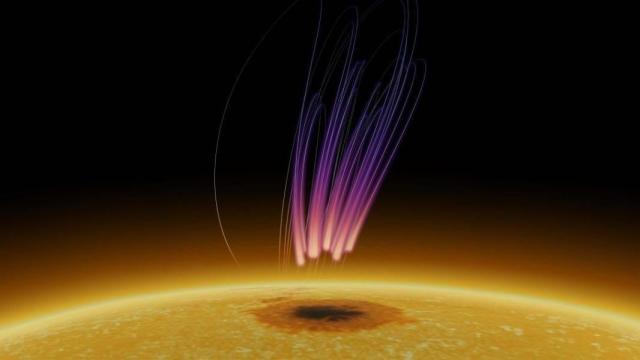Radio emissions detected about 40,000 kilometres above a dark region on the Sun have aurora-like qualities, according to a team of astronomers that studied the emissions.
The emissions were seen above a sunspot— a dark region on the Sun’s surface. Magnetic fields around sunspots are about 2,500 times stronger than Earth’s, according to the National Weather Service, which causes the temperature in sunspots to be cooler than the brighter parts of our star’s surface.
The radio wave emissions were spotted by the Jansky Very Large Array in April 2016, but only now has the research team reported its analysis of the data. The team described the emissions as “aurora-like” based on their spectra, polarization, and duration, among other factors. The team’s analysis was published in Nature Astronomy.
“We’ve detected a peculiar type of long-lasting polarised radio bursts emanating from a sunspot, persisting for over a week,” said Sijie Yu, an astronomer at the New Jersey Institute of Technology’s Center for Solar-Terrestrial Research (NJIT-CSTR) and the study’s lead author, in an institute release. “This is quite unlike the typical, transient solar radio bursts typically lasting minutes or hours. It’s an exciting discovery that has the potential to alter our comprehension of stellar magnetic processes.”
Auroras on Earth happen when charged particles from the Sun come into contact with Earth’s atmosphere and its magnetic field. The gasses in our atmosphere then glow—oxygen in red and the familiar green aurora, and nitrogen in blue and purple, according to NASA.
“Unlike the Earth’s auroras, these sunspot aurora emissions occur at frequencies ranging from hundreds of thousands of kHz to roughly 1 million kHz — a direct result of the sunspot’s magnetic field being thousands of times stronger than Earth’s,” Yu added.
But Earth is even unique in its auroras. Last year, the Webb Space Telescope imaged the auroral regions on Jupiter’s poles, glowing bright blue in a Near-Infrared Camera (NIRCam) view. And just last month, the Near-Infrared Spectrograph (NIRSPEC) of the Keck II Telescope spotted infrared auroras on the edges of Uranus, adding to the already known ultraviolet auroras that sometimes glow above the planet.
The researchers don’t think that the sunspot radio emissions are related to the timing of solar flares; rather, they posit that occasional flares feed electrons into magnetic field loops that hinge on the sunspots. The team also believes that other stars could boast similar “sunspot radio aurora.”
“By understanding these signals from our own Sun, we can better interpret the powerful emissions from the most common star type in the universe, M-dwarfs, which may reveal fundamental connections in astrophysical phenomena,” said Dale Gary, a physicist at NJIT-CSTR and co-author of the paper, in the same release.
Besides ground-based observations like those done by the Very Large Array, spacecraft could help clarify the dynamics at play on the Sun’s surface. NASA’s Solar Orbiter flies directly through coronal mass ejections, giving researchers insights on the nature of the storms, and the agency’s Parker Solar Probe has even dipped into the Sun’s corona.
Even though our Sun has powered life on Earth for billions of years, it still keeps some secrets from us. Thankfully we’re slowly improving our understanding of our local star, the reason for our existence.
